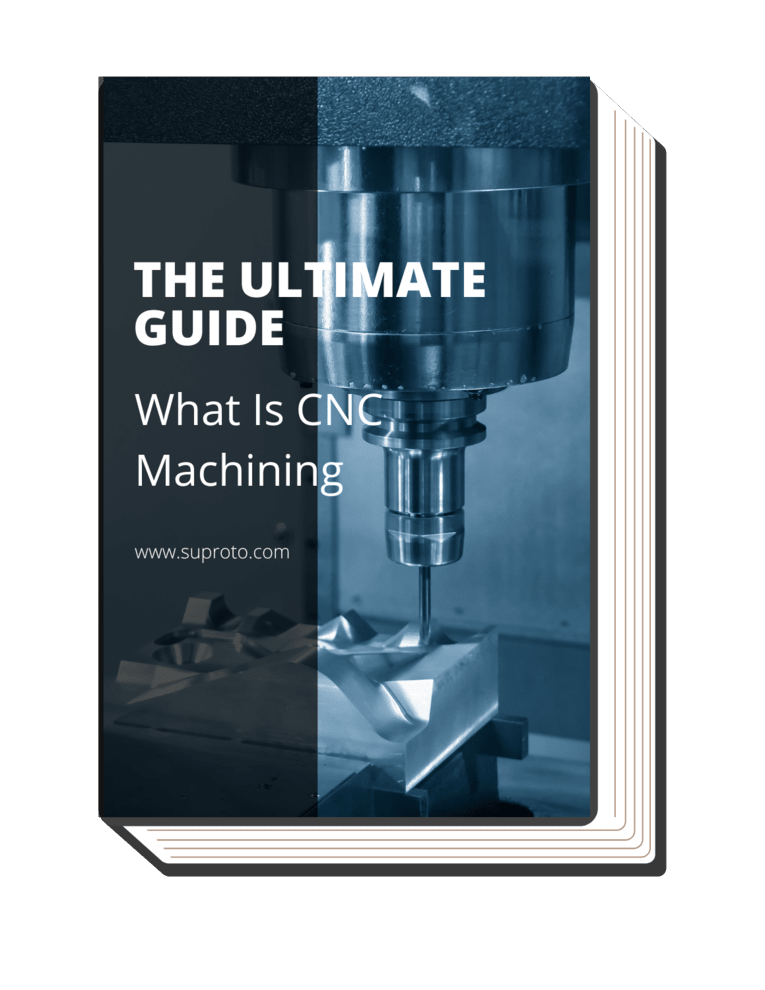Ever found being bewildered by the complex world of gears? As an expert in CNC machinery, I’ve frequently encountered business owners wrestling with this very issue. The plethora of gear types, each with its own specific function, characteristics, and application, often leads to confusion.
But fear not, this comprehensive guide promises to shed light on this intricate terrain. From basic to complex, we will traverse ten different types of gears, highlighting their unique attributes and applications.
So, buckle up, and let’s delve into the fascinating world of gears, enhancing understanding and helping your business make informed decisions!
1. Spur Gear
Spur gears, often viewed as the “poster child” of the gear world, are the perfect starting point for our exploration. Their simplistic design combined with widespread utilization in various industries makes them an excellent introduction to the world of gears.
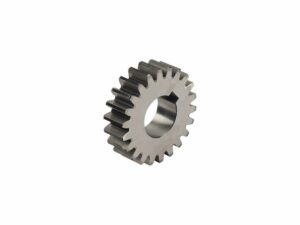
Basics of Spur Gear
Spur gears are the most straightforward type of gears, characterized by their cylindrical shape and straight, parallel teeth that run along the gear’s axis. Their simplistic yet efficient design makes them an ideal candidate for applications requiring steady, consistent power transmission. The simplicity of their construction lends itself to ease of manufacture and maintenance, making them a popular choice across various applications.
Applications of Spur Gear
Thanks to their simplicity and effectiveness, spur gears have made their way into numerous applications. They are a staple in the machinery of many industries, from the automotive industry where they’re used in gearboxes, to the manufacturing sector where they serve in conveyor systems. Spur gears with DLC coating can be found in household appliances such as washing machines and clocks, and even in children’s toys.
The table below provides an overview of the diverse applications of spur gears, demonstrating their widespread utilization across industries ranging from automotive and manufacturing to household appliances and toys.
| Industry/Application |
Description |
| Automotive Industry |
Used in gearboxes to transmit power and torque efficiently, providing different gear ratios for optimal speed and torque requirements. |
| Manufacturing Sector |
Employed in conveyor systems to facilitate smooth material movement along assembly lines, regulating speed and direction. |
| Household Appliances |
Found in washing machines and clocks, where they enable rotational motion for washing and timekeeping functions, respectively. |
| Robotics and Automation |
Integral components in robotic arms and joints, enabling precise and controlled movements for various automation tasks. |
| Toys and Hobbyist |
Commonly used in toys, model trains, and hobbyist applications, providing mechanical movement and gear reduction or amplification for various motion effects. |
Pros and Cons of Spur Gear
Commonly referred to as the simplest gear type, the spur gear holds a unique place due to its efficiency and broad applications. Here are some pros and cons of spur gear:
Pros:
- Straightforward design makes it simple to manufacture and maintain.
- High power transmission efficiency due to the direct contact of the gear teeth.
- They operate very smoothly and quietly if well-manufactured and aligned properly.
Cons:
- Can produce a lot of noise when operating at high speeds.
- It cannot be used for transmitting power between non-parallel shafts
2. Helical Gear
The complex design of helical gear offers us a deeper dive into the world of gears. The intricacies of helical gears provide a fascinating contrast and contribute significantly to the diversity of gear technology.

Basics of Helical Gear
The helical gear is named for the angled or helix arrangement of its teeth. This unique design makes for a distinct operation, quite unlike the spur gear. Rather than engaging all at once, the teeth of a helical gear engage gradually and smoothly, reducing abrupt stress on each tooth and leading to quieter operation with less vibration.
Applications of Helical Gear
At Suproto, the smooth and quiet operation makes the helical gear a favorite for use in high-speed, high-torque, and heavy-load applications. From high-performance automobile transmissions to heavy machinery in industries such as mining and construction, helical gear has proven its worth. Based on my experience, they are also favored in power plants and other industries where noise reduction is of the essence.
Pros and Cons of Helical Gear
The twisted, unique design of the helical gear provides more surface contact for power transmission. Here are some of its pros and cons:
Pros:
- Operates more smoothly and quietly than spur gears due to the angle cut of the gear teeth.
- More teeth are in contact at any given time, which allows for higher load capacity.
- Can transmit power between parallel or non-parallel, and same or opposite direction shafts.
Cons:
- More complex to design and manufacture than spur gears, making them more expensive.
- The angled teeth can lead to axial thrust loads, requiring appropriate bearings.
3. Gear Rack
Entering the world of linear gears, we find the gear rack. This gear variety showcases the incredible diversity in gear design, offering a different kind of movement from what we’ve seen so far.
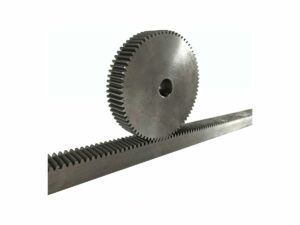
Basics of Gear Rack
A gear rack isn’t round like the gears we’ve explored so far; instead, it’s a straight or flat piece with teeth along one side. It’s essentially a portion of a gear with an infinite radius. When a pinion or circular gear engages with a gear rack, it transforms the pinion’s rotational motion into linear motion.
Applications of Gear Rack
Because of their unique ability to convert rotational motion into linear motion, gear racks are employed in a wide range of applications. For instance, they are crucial components in rail transport, such as trains and trams, as well as in automated machinery like CNC machines. Even everyday items like sliding gates and doors use gear racks for smooth operation.
Pros and Cons of Gear Rack
Gear racks are versatile components that find applications in diverse fields. Let’s explore the pros and cons of gear racks:
Pros:
- Gear racks provide efficient and reliable linear motion transfer
- They offer a cost-effective solution for converting rotational motion to linear motion and vice versa.
- Gear racks can handle high loads and provide consistent velocity
Cons:
- Gear racks are susceptible to backlash
- Wear and tear can occur over time due to the constant contact between the gear and the rack
4. Bevel Gear
Our journey through the landscape of gears takes a significant turn as we approach bevel gears. With their unique design and specialized applications, bevel gears are an essential element in the world of power transmission.
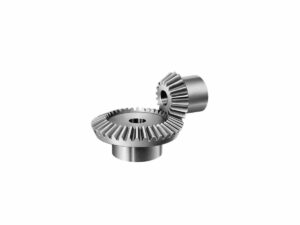
Basics of Bevel Gear
A bevel gear is characterized by its conical shape, quite different from the cylindrical shapes of spur and helical gears. The teeth of a bevel gear can be straight (like a spur gear), helical (like a helical gear), or even curved in the shape of an arch (known as a spiral bevel gear). The unique design of bevel gears allows them to transmit power between axes that are intersecting, typically at right angles.
Applications of Bevel Gear
Due to their ability to change the direction of rotation while transmitting power, bevel gears find significant applications in many areas. They’re widely used in automotive applications, such as differential drives, which allow the wheels of a vehicle to rotate at different speeds. Amazing, right? Other applications include hand drills, where bevel gears transfer power from the rotary handle to the drill bit at a right angle.
Pros and Cons of Bevel Gear
Used primarily for transmitting power between intersecting shafts, bevel gears offer a balance of complexity and utility. Let us assess its pros and cons:
Pros:
- Ideal for transmitting power between intersecting shafts.
- They come in different types, increasing their adaptability for different needs.
- The design allows for gradual engagement of teeth, reducing noise and vibrations.
Cons:
- More difficult to manufacture than spur and helical gears, leading to increased cost.
- They are not as strong as equivalent spur or helical gears and are less efficient in power transmission.
5. Spiral Bevel Gear
As we delve deeper into the realm of bevel gears, the spiral bevel gear presents a more intricate layer. With its curved teeth and the unique way it handles loads, the spiral bevel gear showcases the diversity of gear mechanics.
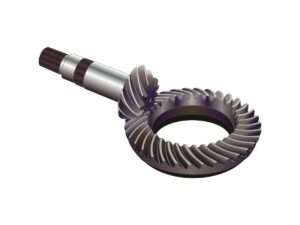
Basics of Spiral Bevel Gear
Spiral bevel gears are a sophisticated variant of bevel gears. Unlike regular bevel gears with straight teeth, the teeth on a spiral bevel gear are curved and oblique. The term ‘spiral’ comes from the teeth’s resemblance to segments of a helix. Believe me, this elaborate design allows for more gradual and smoother engagement of the teeth, ensuring quieter operation and less vibration.
Applications of Spiral Bevel Gear
Given their smoother and quieter operation, spiral bevel gears find applications in areas where noise and vibration reduction is paramount. A prime example of their application is within the automotive industry – specifically in the differentials of vehicles. This allows the wheels to rotate at different speeds, a necessary function when taking turns.
Pros and Cons of Spiral Bevel Gear
Spiral bevel gears are a sophisticated variant known for their smooth operation and load-bearing capabilities. Let us delve into the pros and cons of spiral bevel gears:
Pros:
- The operation of these gears is known for its quietness, adding to overall system efficiency.
- They are capable of handling larger loads due to their increased tooth contact.
- The smoother operation allows for reduced vibration and noise, enhancing the longevity of the equipment.
Cons:
- The intricate design of spiral bevel gears may escalate manufacturing costs.
- Their complexity might require additional time for maintenance and replacements.
6. Screw Gear
Screw gears take us into an entirely different aspect of the gear world. They demonstrate how design alterations can enable power transmission in different orientations.
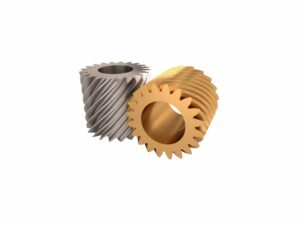
Basics of Screw Gear
According to Tec-Science, screw gears or crossed helical gears are hyperboloid gears that allow the skew mating of the gear shafts. Thanks to their helix angle, it enables the shafts to cross each other at a certain point. Their design is a result of a need to transmit power and motion between non-parallel, non-intersecting shafts.
Applications of Screw Gear
Screw gears are primarily used in applications where power transmission between non-parallel, non-intersecting shafts is required. This includes various mechanical devices, including certain types of door-opening mechanisms and adjustable medical equipment. They also find usage in textile machinery and other specialized industrial equipment.
Pros and Cons of Screw Gear
Screw gears serve as a unique solution for non-parallel, non-intersecting power transmission, displaying the flexibility of gear designs. Let’s unpack the pros and cons of screw gears:
Pros:
- Screw gears uniquely facilitate power transmission between non-parallel, non-intersecting shafts.
- They provide design solutions for complex mechanical challenges.
- Their distinctive design allows them to serve in unique roles within intricate mechanical systems.
Cons:
- Screw gears’ unique design can lead to increased friction and wear.
- This might result in lower transmission efficiency and heightened manufacturing difficulties.
7. Miter Gear
Continuing our journey through the diverse realm of gears, we come across miter gears—a fascinating type of bevel gear that plays a crucial role in transmitting power at right angles. With their unique design and applications, miter gears offer a versatile solution to mechanical challenges.

Basics of Miter Gear
Miter gears, also referred to as bevel gears with a 1:1 gear ratio, are specifically crafted to facilitate power transmission between two intersecting shafts at a perfect 90-degree angle. Unlike other bevel gears that may have varying tooth counts, miter gears possess the same number of teeth on both the pinion and the gear, resulting in a direct speed ratio between the input and output shafts.
Applications of Miter Gear
At Suproto, miter gears find application in a wide range of mechanical systems where the redirection of power at a right angle is required. In my opinion, one of the most common applications of miter gears is in hand tools such as hand drills, where they efficiently transmit rotational power from the handle to the chuck at a perpendicular angle.
Pros and Cons of Miter Gear
Miter gears, a type of bevel gear with a 1:1 ratio, are pivotal in transmitting power at right angles. Here let us discuss the pros and cons of miter gears:
Pros:
- Miter gears excel in power transmission at right angles, paving the way for versatile mechanical designs.
- They are ideal for applications requiring sharp directional changes.
- These gears have a 1:1 gear ratio, making them perfect for cases where the power speed needs to remain constant.
Cons:
- These gears can be susceptible to higher levels of sliding friction.
- This susceptibility might lead to increased wear and, subsequently, reduced efficiency.
8. Worm Gear
As we delve deeper into the realm of gears, we come across intriguing and efficient worm gear. With its distinctive helical configuration, worm gear offers a unique set of advantages and applications.
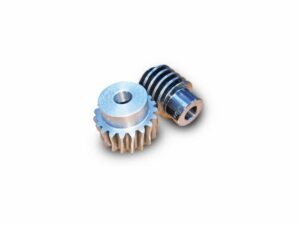
Basics of Worm Gear
A worm gear consists of a threaded cylindrical gear, known as the worm, and a toothed gear, known as the worm wheel or worm gear. The worm features a helical thread that meshes with the teeth of the worm wheel, creating a gear mechanism that provides high torque and a compact design.
Applications of Worm Gear
Worm gears are widely used in applications that require high reduction ratios and self-locking capabilities. They find extensive use in conveyor systems, packaging machinery, elevators, and even in the automotive industry for steering systems. What I like about the self-locking property of worm gears, is it makes them suitable for applications where the prevention of back-driving is crucial.
Pros and Cons of Worm Gear
Worm gears stand out due to their high reduction ratios and ability to serve as a locking mechanism. Let’s delve into the pros and cons of this gear type:
Pros:
- High reduction ratios can be achieved due to the unique design of the worm and gear.
- It has a self-locking feature, which can prevent the system from spinning backwards.
- Operates quietly and smoothly because only one or two teeth are in contact at a time.
Cons:
- Has lower efficiency in power transmission due to sliding contact.
- The worm must be made from a harder material than the gear, limiting material choices.
9. Rack and Pinion Gear
Here, we encounter the dynamic duo of rack and pinion gears. This powerful combination plays a crucial role in translating rotational motion into linear motion and vice versa, offering a versatile solution to a wide range of mechanical systems.
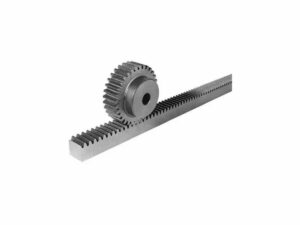
Basics of Rack and Pinion Gear
The rack and pinion gear system consists of two main components: the rack and the pinion. The rack is a straight, flat gear with teeth running along its length, while the pinion is a circular gear with meshing teeth that engage with the rack. This engagement allows the rotational motion of the pinion to convert into linear motion along the rack, or vice versa.
Applications of Rack and Pinion Gear
The rack and pinion gear system finds extensive applications in various industries. One of the most common uses is in the automotive industry, where it is employed in power steering systems to convert the rotational motion of the steering wheel into linear motion for smooth and precise vehicle control.
Pros and Cons of Rack and Pinion Gear
Rack and pinion gears combine to play a crucial role in converting rotational motion to linear and vice versa. Here let us outline the pros and cons of rack and pinion gears:
Pros:
- Rack and pinion gears offer high precision and accuracy, facilitating smooth, reliable motion control.
- They play a pivotal role in converting rotational motion into linear motion and vice versa.
- The design enables consistent and reliable performance over long periods.
Cons:
- There is a potential for backlash, which is a slight movement or play between the rack and pinion when direction of motion changes.
- Over time, this backlash can lead to decreased performance and accuracy.
10. Planetary Gear
Under complex gear systems, we’ll discuss intricate and versatile planetary gears. With their distinctive design and applications, planetary gears offer unique advantages in various mechanical systems.
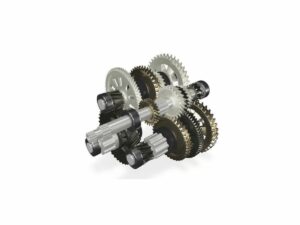
Basics of Planetary Gear
A planetary gear system consists of three main components: the sun gear, planet gears, and ring gear. The sun gear is located at the center and is surrounded by multiple planet gears, which in turn mesh with an outer ring gear. Anyone will agree that this arrangement will help allow for multiple points of contact and power transmission.
Applications of Planetary Gear
Planetary gears find extensive use in a wide range of applications. According to The Drive, planetary gears are used in applications where space is limited, as they are typically smaller than other types of gearboxes. Planetary gears are also utilized in industrial machinery, wind turbines, robotics, and even in watches and clocks.
Pros and Cons of Planetary Gear
Planetary gears, known for their unique assembly and compact design, offer a range of advantages and disadvantages. Let us probe into the pros and cons of planetary gears:
Pros:
- Planetary gears’ high gear ratios, compact form, and unique assembly make them suitable for efficient power transmission in space-limited applications.
- The design allows for an impressive torque-to-weight ratio.
- They provide high stability due to the load being distributed among multiple planetary gears.
Cons:
- The complexity of planetary gears can increase manufacturing and assembly challenges.
- This complexity may potentially escalate overall costs.
Dive Deeper Into Our Resources
Looking for more diverse service options? Browse through our handpicked selections:
For some insightful reads, we’ve curated a list of recommended articles just for you:
Still haven’t found what you’re looking for? Don’t hesitate to contact us. We’re available around the clock to assist you.
Conclusion
Understanding the different types of gears is essential for business owners and professionals in industries where precision, power transmission, and mechanical systems play a pivotal role. By grasping the basics, applications, and pros and cons of each gear type, businesses are empowered to make informed decisions that align with their needs and goals.
As you navigate the world of CNC machinery and gear systems, remember that Suproto, a reputable gear manufacturer, is here to assist. Whether your business requires custom gear solutions, expert advice, or reliable products, we are committed to providing top-notch service and expertise. Contact us now and gear up for a future of excellence!










